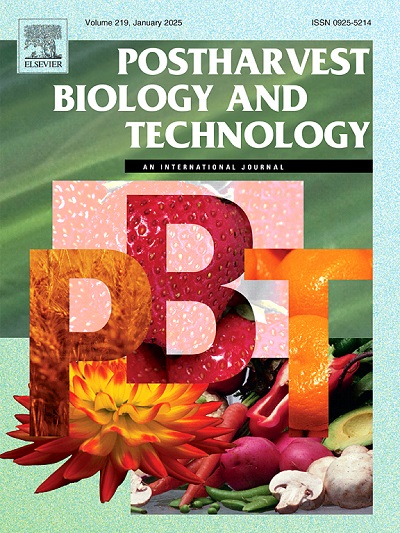Exogenous NaHS maintains storage quality of Prunus salicina ‘Wushan plum’ by regulating the antioxidant system, endogenous H2S, ethylene and NO metabolism
IF 6.4
1区 农林科学
Q1 AGRONOMY
引用次数: 0
Abstract
Prunus salicina ‘Wushan plum’ is a climacteric fruit, which rapidly ripens under the action of ethylene after harvesting, resulting in quality deterioration that seriously restricts the sustainable development of the industry. In order to examine the potential role of sodium hydrosulfide (NaHS, the donor of exogenous H2S) in slowing down the ripening and senescence process of plum fruit, the changes in storage quality, antioxidant capacity, endogenous signals and gene expression levels were evaluated during storage at 25 °C for twelve days. The results indicated that NaHS treatment delayed the coloration of plum fruit and maintained higher firmness, titratable acid content (TA) and marketable fruit rate. Treatment with NaHS increased the activities of catalase (CAT), superoxide dismutase (SOD), glutathione reductase (GR) and ascorbate peroxidase (APX); promoted the accumulation of total phenols (TP) and ascorbic acid (AsA), and inhibited the increase in reactive oxygen species (ROS), malondialdehyde (MDA) and lipoxygenase (LOX) activity, which in turn alleviated oxidative damage. H2S treatment down-regulated the expression of PsACO1 and PsACS1 and inhibited the production of ethylene; up-regulated the expression of PsSiR, PsSAT, PsOASTL, and PsLCD, which in turn elevated the activities of sulfite reductase (SiR), serine acetyltransferase (SAT), O-acetylserine cleavage lyase (OASTL), and L-cysteine desulfurylase (LCD), and facilitated the accumulation of the endogenous H2S content; up-regulated the expression of L-Arginine synthesis-related genes and PsNOA, which increased the content of L-Arginine as well as the activity of nitric oxide synthase (NOS) and facilitated the synthesis of nitric oxide (NO). The above results indicated that NaHS could improve the antioxidant system, endogenous H2S, ethylene, and NO metabolism of plum, thus maintaining the storage quality of the fruit.
求助全文
约1分钟内获得全文
求助全文
来源期刊

Postharvest Biology and Technology
农林科学-农艺学
CiteScore
12.00
自引率
11.40%
发文量
309
审稿时长
38 days
期刊介绍:
The journal is devoted exclusively to the publication of original papers, review articles and frontiers articles on biological and technological postharvest research. This includes the areas of postharvest storage, treatments and underpinning mechanisms, quality evaluation, packaging, handling and distribution of fresh horticultural crops including fruit, vegetables, flowers and nuts, but excluding grains, seeds and forages.
Papers reporting novel insights from fundamental and interdisciplinary research will be particularly encouraged. These disciplines include systems biology, bioinformatics, entomology, plant physiology, plant pathology, (bio)chemistry, engineering, modelling, and technologies for nondestructive testing.
Manuscripts on fresh food crops that will be further processed after postharvest storage, or on food processes beyond refrigeration, packaging and minimal processing will not be considered.
文献相关原料
公司名称
产品信息
阿拉丁
NaHS
 求助内容:
求助内容: 应助结果提醒方式:
应助结果提醒方式:


